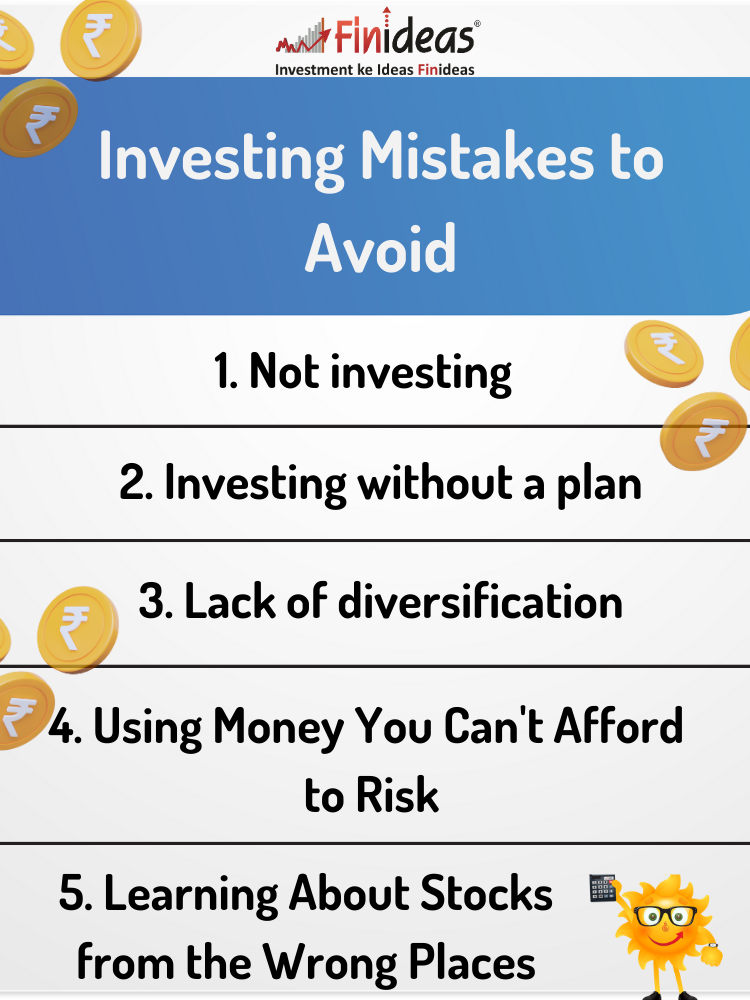Investing mistakes to avoid
Introduction:
Embarking on the journey of investing can be both thrilling and rewarding, but it’s not without its pitfalls. In the ever-changing world of finance, avoiding certain mistakes is crucial to safeguarding and growing your wealth. In this guide, we’ll explore some common investing mistakes and strategies to steer clear of financial pitfalls.
Not investing
Skipping out on investing is a missed opportunity that goes beyond just playing it safe. It’s like letting your money sit on the sidelines while inflation nibbles away at its value. Investing isn’t just about numbers; it’s about making your money work for you. It’s the difference between a stagnant savings account and a portfolio that grows over time. Think of it as planting seeds for your financial future. Sure, there’s risk involved, but there are smart ways to navigate that. Diversification is like having a financial safety net. So, don’t let fear hold you back—start small, seek advice, and watch your wealth potential unfold.
Investing without a plan
Picture investing like embarking on a journey without a map or destination. Without a plan, emotions might take control, steering your investments into unpredictable territory. Understanding your investments is akin to having a reliable compass – it keeps you on track. Neglecting research is like navigating in the dark; you might encounter unforeseen obstacles. Successful investing demands a solid plan, in-depth knowledge of your investments, and staying informed. It’s the distinction between a well-planned adventure and wandering aimlessly. So, equip yourself with a financial compass, chart your course, and venture confidently into the realm of investments.
If you are interested in investing but do not have a plan than you must know about ILTS.
Lack of diversification
Investing all your money in a single asset is like placing all your bets on a solitary horse in a race. While it may lead to a thrilling victory, it also invites the risk of a heartbreaking defeat. Lack of diversification means you’re vulnerable to the unpredictable twists of a single market or industry. Just as a diverse portfolio is your financial safety net, concentrating on one investment is akin to walking a tightrope without a safety harness. Spreading your investments across various assets mitigates risks, ensuring that if one falters, others can compensate, providing a smoother journey towards financial success. Remember, in the investment race, a diversified approach is the winning strategy that navigates the highs and lows of the market terrain.
Using Money You Can’t Afford to Risk
Investing money you can’t afford to risk is a common pitfall, akin to walking a financial tightrope without a safety net. Emotions run high, clouding judgment and triggering impulsive decisions. According to behavioral finance, this emotional turbulence often results in significant losses. Research shows that investors who risk funds crucial for necessities, like rent or emergency savings, are more prone to panic selling during market downturns. This knee-jerk reaction locks in losses and hinders long-term wealth accumulation. In contrast, successful investors strategically allocate funds they can afford to risk, allowing for a calmer, more rational approach This data underscores the importance of aligning investments with financial resilience, steering clear of the perilous path of jeopardizing essential funds for potential gains.
Learning About Stocks from the Wrong Places
Relying on unreliable sources for stock tips can lead to costly mistakes. There is no shortage of so-called experts who are willing to offer their opinions while presenting them as if they are educated and endlessly correct. Learn where to seek credible information, you could also consult a financial advisor to guide you through the process.
Conclusion:
In the dynamic world of investing, avoiding common pitfalls is crucial for long-term financial success. By understanding the importance of planning, diversification, and reliable information sources, you can navigate the complex investment landscape with confidence. Remember, investing is not just about numbers; it’s about making informed decisions that align with your financial goals and aspirations.
Considering the pitfalls mentioned, which one do you find most challenging to overcome in your own approach to investing, and what steps do you plan to take to address it?
Happy Investing!
This article is for education purpose only. Kindly consult with your financial advisor before doing any kind of investment.


